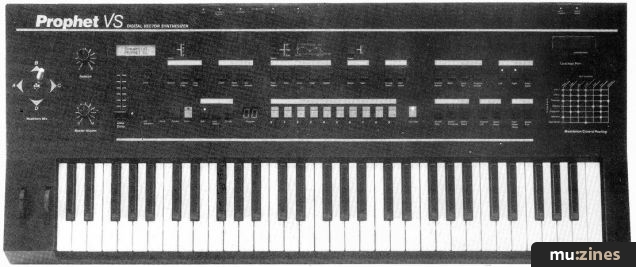Magazine Archive
Home -> Magazines -> Issues -> Articles in this issue -> View
Sequential Prophet VS Polysynth | |
Article from Electronics & Music Maker, March 1986 | |
An exclusive preview of Sequential's first-ever digital synth: Paul Wiffen reckons it's been worth the wait.

At this early stage, there are a lot of unanswered questions surrounding the Prophet VS. Will its new sound-generating system — Vector Synthesis — revolutionise the synthesiser world? Will it make musicians turn away from sampling and go back to creating sound electronically, instead of just manipulating it that way? Will it render the DX7 obsolete?
Frankly, I haven't got a clue. What follows is not a detailed rundown, but a sneak preview gleaned from a couple of demonstrations and a few hours' fiddling at Sequential's factory in San Jose.
What the Californians have set out to do with the VS is to use the clarity and stability of digital electronics, implemented in a way synth programmers will understand. This is nothing new, as a number of other design teams have looked at Yamaha's FM synthesis technique and asked themselves: 'How can we make this more accessible?' Trouble is, most of their answers have consisted of simplifying circuitry, making it easier to use than FM but, at the same time, quite a bit less versatile.
The VS is the first synth that really grabs the programming bull by the horns, offering a complex voice configuration you can use — quickly, easily and enjoyably.
There are four digital oscillators routed through a classic four-pole filter, followed by a wide range of envelope controls. More unusually (and this is where the fun starts), each oscillator can use one of 160 different waveforms, 128 of which are preset and 32 user-programmable. Creation of new waveforms is achieved by a staggeringly simple process which should go down a storm with video game junkies: you just grasp the onboard joystick firmly in one hand, select four waveforms as a starting point, and create a brand new waveform using the joystick to create a unique four-way mix. This is waveform creation in real time, faster than FM by about the same magnitude as a Ferrari is faster than an Austin A40 (I should know, I've got an A40).
Following on from this, everything else in the VS' sound-changing department is closely related to traditional analogue programming techniques. The four 12-bit oscillators can be mixed using 12-parameter envelopes or via the joystick, giving you an extra real-time control to waggle in addition to the bend and mod wheels. Five-stage envelopes also control filtering and loudness, with the fascinating addition of looping and repeat functions — useful results of Sequential's excursion into sampling with the Prophet 2000 and 2002.
Both sound patches and additional user-programmed waveforms can be stored on cartridge, and these are instantly available and editable during performance.
But the success of Sequential's analogue/digital mixture only becomes fully apparent when you listen to the noises the VS makes. The contrast between synthetic strings (as full and as warm as they ever were on the Prophet 5) and the precise cutting edge of new percussive sounds is as stark as any in synth technology, and you have to pinch yourself before you believe that both are coming from the same machine.
Sequential have again excelled themselves on the MIDI front, providing a selection of interfacing facilities even more versatile than that of the Prophet 2000. The VS is multi-timbral, of course, and the prospect of using it in conjunction with a sampler and a MIDI sequencer is mouthwatering.
We'll be giving the VS a fuller appraisal just as soon as we get our hands on one.
Only then will we discover if it really is such a cinch to work with, if the range of preset sounds really does contain voices of a uniformly high standard, and if it really will make prospective DX7 purchasers think long and hard before committing themselves.
It's due to sell in the UK for about the same money as the Prophet 2000 (under two grand, in other words), and from the evidence we've seen so far, Sequential should have little trouble selling it.
Also featuring gear in this article
Prophecy Fulfilled - Prophet VS
(EMM May 86)
Sequential Prophet VS - Synthcheck
(IM Aug 86)
Sequential's Prophet VS... - The new-wave sound
(SOS Jul 86)
Browse category: Synthesizer > Sequential Circuits
Publisher: Electronics & Music Maker - Music Maker Publications (UK), Future Publishing.
The current copyright owner/s of this content may differ from the originally published copyright notice.
More details on copyright ownership...
Review by Paul Wiffen
Previous article in this issue:
Next article in this issue:
Help Support The Things You Love
mu:zines is the result of thousands of hours of effort, and will require many thousands more going forward to reach our goals of getting all this content online.
If you value this resource, you can support this project - it really helps!
Donations for May 2024
Issues donated this month: 0
New issues that have been donated or scanned for us this month.
Funds donated this month: £0.00
All donations and support are gratefully appreciated - thank you.
Magazines Needed - Can You Help?
Do you have any of these magazine issues?
If so, and you can donate, lend or scan them to help complete our archive, please get in touch via the Contribute page - thanks!







